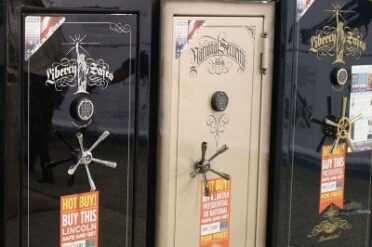
The wide variety of sizes and specifications allows for protection for both those on more limited budgets and those who are willing to pay for more accoutrements.
By David Higginbotham
Liberty Safe
https://www.libertysafe.com/
A couple of years ago, I decided I needed something larger than my bedside fast-access handgun safe. I inherited a couple of worthless pistols from my father’s estate, and I loved them more than anything else I owned. My bedside safe offered no real fire protection. Its size and relatively light weight made my little safe a convenient way for a crook to carry my valuables out of the house. So I went in to see my FFL. The refrigerator-sized safes that lined the floor of the shop were visually impressive. Yet the visual impressiveness was short lived. When I knocked on their sides, they rang like old tin garbage cans. They were bigger, but not much better than what I already had. I needed a real safe. So what actually makes a safe worth buying? Let’s take a look inside a Liberty.
I needed something bigger, stronger, fireproof, and impervious to burgling miscreants. I find it is almost impossible to judge safes by their exteriors. There are some companies, Liberty included, that put extra emphasis into the graphics and paint jobs. While most of the safes on the market are available in a variety of greys and blacks (both glossy and matte), Liberty offers a wider variety of colors and some extra graphics on some models, but you really aren’t paying for paint.
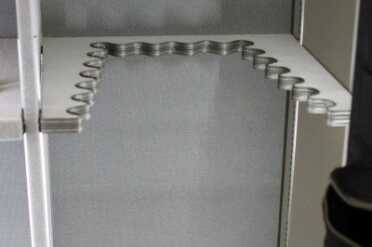
A handy rack inside the Lincoln helps keep long guns safely separated. This one holds 17, and there are two of them inside this safe.
Making it harder for criminals
Instead, you should concern yourself with the quality of the safe’s construction. One of the first things that you should look into is loss prevention. A good safe should keep prying hands out. While a low-cost safe will keep kids and stupid criminals out, anyone with half a brain (and even a modest set of tools) can open it like a tin can.
You want to pay attention to the thickness of the steel. This one is from Liberty’s Lincoln line and has a thick skin: 11 gauge steel. All of the seams are welded, completely. Some companies tack-weld their safes and fill in the voids with Bondo and paint. Bondo has its place, but you don’t want it to be the first barrier any thief will have to overcome.
The Lincoln 50 stands 72 inches tall, and is 42 inches wide and 32 inches deep. That’s enough interior storage for 41 guns, according to Liberty’s count. This is, of course, dependent on the size of your guns, how they are outfitted and how easily you want to access them. Any way you cut it, it is a wide safe. It is wide enough to lay an AR-15 flat on the top shelf, easily. I think the number is a bit low, and I intend to test it, though I haven’t yet.
The next point of concern should be the bolts that hold the door secure. The more bolts, the better. This Liberty has 16 bolts, and all of them are active (meaning they retract and engage). The construction of the bolt, and its length and width is also important.
Liberty Lincoln has bolts that are 2 inches long and 1.25 inches wide. There are bolts in all four sides of the door, which is a huge improvement over some safes that have fixed studs in the hinged side and nothing on the bottom. If one of those is tipped on its side or back, the bottom becomes easy to pry open.
Bolts on all four sides and a thick skin will only go so far. Locks have to have secure features that keep them from being compromised. The best protection available against drilling is a plate full of ball bearings. The Lincoln has one to protect its lock’s guts. When a thief tries to drill out the lock, the drill bit will hit these bearings. If the bit catches in the hardened bearing plate, it will break. If it connects with the bearings, they will simply spin, preventing the drill from penetrating further.
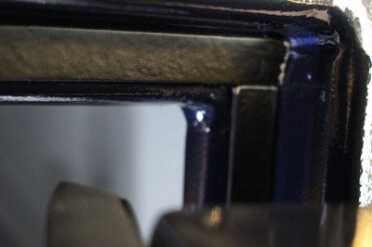
A Palusol door seal will expand during a fire to seal out any air transfer, even if the heat of the fire warps the door.
Keeping your treasures safe from the elements
Once you’ve established some basic protections against outside, two-legged threats, you may wish to consider how a safe will stand up to natural disasters. Fire is always one of the big dangers. A good safe should seal tightly to prevent an exchange of moisture, but a good fire seal is also a plus. Palusol door seals are an industry standard. This thin membrane expands when heated and seals up a safe. The Lincoln line is rated for 90 minutes at 1,200 degrees. How much fire protection you need depends on how far you live from a fire station and how long it would take to get a fire under control and out. In my case, I’m protecting a couple of guns that aren’t worth anything. That said, I can’t ever replace them. It isn’t the gun that’s valuable, but the memory of my father. I want as much fire protection as I can get.
The fire protection is inside the steel. Fireboard is stacked, sheet on sheet, and lapped inside the safe. Each additional layer helps shield the contents from a fire outside of the safe. Higher fire ratings are earned by filling the inside space with fire board, which isn’t light. While weight does slowly add up, it provides a mass that gives the safe some extra protection, and the loss of interior space is negligible. Pay attention, though, to where you place the safe, especially a heavy one. Liberty’s Lincoln isn’t a lightweight. Even empty (still 1,115 pounds), the Lincoln can put some serious stress on poorly constructed structures. And even fire-resistant safes can be compromised when they fall though a burning floor.
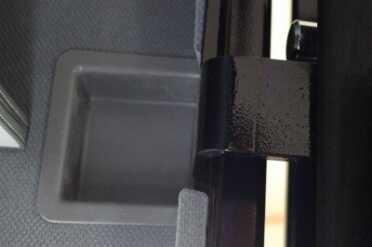
Even on the backside of the door, an active bolt (just above this hinge) will help to secure a safe. Some safes have fixed posts on the back side of the door which cuts costs, but compromises security.
How can you keep a safe safe?
If you can, place the safe close to the foundation. Then bolt it to the concrete floor. If you can’t sink lag bolts into concrete, consider bolting it down anyhow. Make sure it is where you want it, and lock it down. It is best to avoid exterior walls. Burglars have been known to drill through exterior walls, wrap chains around the safes, and pull them through the walls. It isn’t an easy task, really, but it can be done. The most secure safes can be stolen. Extra weight inside the safe can help. It is a good excuse to buy more guns. You have to weigh down the safe, right?
This is where many are really tempted by the big safes offered at cut-rate prices by the discount houses. My FFL, which is located in a tiny town, had been in the habit of stocking inexpensive safes. These were the ones I was knocking on that sounded oddly hollow. And it wasn’t because they were empty. They were more like shells than safes. Their walls are thin. Their fire protection is minimal. This makes them easier to move, which some find attractive. It is nice to rock back a safe and muscle it into position. Yet when you buy a light safe, you are sacrificing all of the features that make a safe safe. Sure, you can spend the savings on more guns, but you are gambling, at best.
If you want to move a heavier safe, get help. Find those trusted friends who can help move it around. Go the extra step and have it delivered. Many shops will have special lifts to help overcome stairs and obstacles. If you have hardwood, tile or linoleum floors, a safe can be moved around using nothing but wooden dowels. The heaviest safes will roll on unbelievably small dowels.
Consider the extras, as they are built into the price
There are other benefits to the Liberty line. The Lincoln is upholstered nicely. The modularity of the interior space allows for the storage of all manner of valuables. The shelves can be arranged to your preferences, and there are even drawers for smaller items, like jewelry. The door panels are great for pistols and extras that are easily swallowed whole in a safe this size. Once plugged in, the Lincoln line offers excellent interior lighting. There are more advanced features that govern the way the lock engages and the over-center cam-drive operates that will make the bottom-end safes seem even more ridiculous.
Liberty’s Lincoln 50 isn’t cheap. The MSRP begins at $3,539. While that represents a significant investment for almost everyone I know, we’re talking about genuine protection. I know some shooters who have at least that much wrapped up in one tricked out AR-15. Why would you invest in firearms and then store them in cut-rate weapon lockers? It doesn’t make much sense. Still, the Liberty Lincoln line is high up on Liberty’s list. The Revere line, which still offers serious protection, starts just under $1,000. At that price, there’s really no excuse.
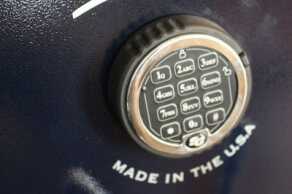
Liberty offers traditional dial locks and electronic keypad locks. Which one is better? It is a matter of personal preference. How often will you open and close the safe? A keypad is much faster.
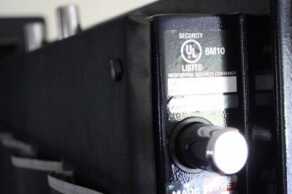
Make sure whatever safe you buy has been tested by an independent agency. While I tend to trust what most folks say about their products, I like to have some impartial verification.
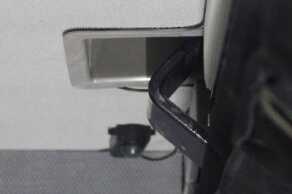
Hinges are always a weak point in door construction. Liberty protects them by placing them inside the safe.
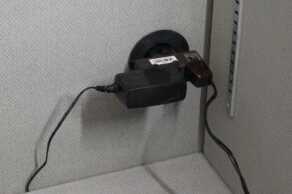
Liberty’s Lincoln line has well-insulated sockets that make plugging in dehumidifiers and lights easy.
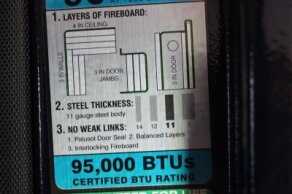
Inside the door of most safes will be all of the basic information. This makes comparing models easy.
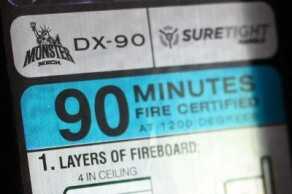
If the company wants to brag about a feature, you’ll see it here on this sticker. 90 minutes of fire protection is worth crowing about.
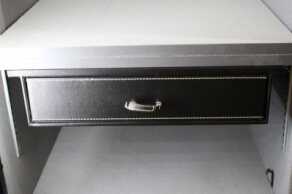
A jewelry drawer can be helpful when trying to keep small guns safe. Or you can use it for jewelry, if that’s your thing.
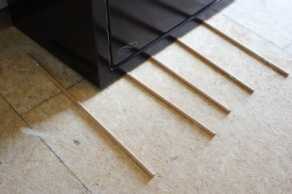
The Egyptians rolled massive stone blocks on simple wooden rollers. Hardwood dowels make moving a safe easy enough that two people can do it with little difficulty.
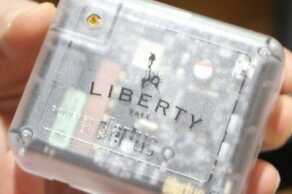
Liberty offers a fantastic monitoring device that will keep you alerted to what’s happening to your safe. Wirelessly. 24/7. It is worth looking into, no matter what kind of safe you have.
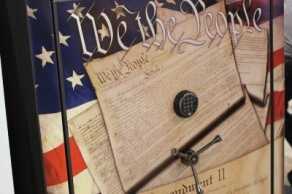
Though most safes are simple in their adornment, Liberty can dress them up. This one makes a statement.
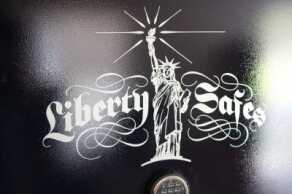
This Liberty Lincoln is adorned with the image of Lady Liberty herself, and not Honest Abe, or the infamous Towncar.


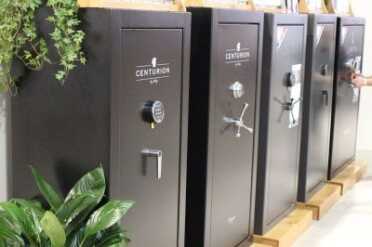
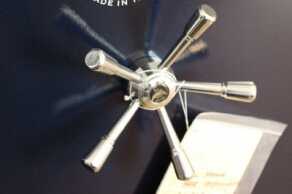
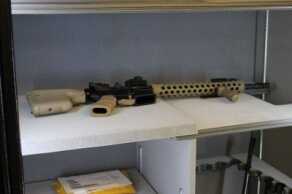
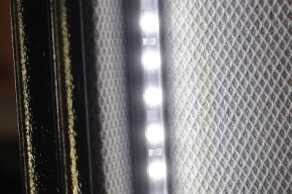
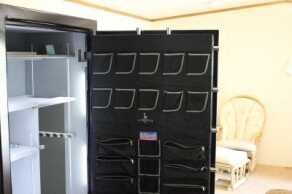
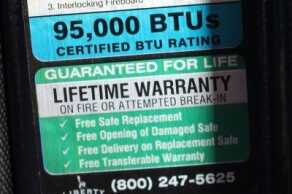
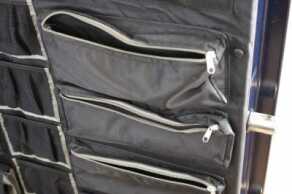

Enemy units will automatically attack the next closest building,
so by interspersing non-essential buildings with your weapons,
you are giving yourself more time to eat away at the enemy’s health and energy.
What to look for in a gun safe?
DON’T BUY A GUN SAFE.
Go on craigslist, look in the business items for sale and search under “safe” or “vault”.
You will find many many REAL safes that are being sold for pennies on the dollar. They will not be pretty.
They won’t have a “gun” interior. But most will have shelves , which work fine for handguns.
I keep my long guns in socks, so the ability to stack them tight is a plus.
In my area, right now, I can purchase a safe with a 1/2 inch steel body and a 1″ steel door UL rated at TL-15 (google it, its much much more secure than the RSC rating most gun safes carry)
for $1500.
This is a real safe with real protection. It can’t be compromised with a sawzall and a sledge hammer.
If you want a pretty conversation piece, buy a guns safe. If you want protection, get a commercial UL rated safe.
Don
One other thing. 11 ga steel, like the Liberty Lincoln is made of is .128″ thick. Most commercial safes start at .5″ and back that with an aggregate designed to foul metal cutting tools.
Good article. Regarding… “You can get a tramp stamp for your safe. These extra flourishes are wholly decorative, though, and offer very little in terms of extra security.” … Just what “extra security” does it offer? 🙂
Thanks for the article. While I’m happy with my Morgan safe, which I believe was a subsituary of Browning, I’ve been looking for a companion safe and all I can find locally are Chinese tin cans with cheap electronic key pads, which as my wife pointed out that unless I wanted to enclose the safe in a Faraday Box the electronic key pad would be useless if there was an EMP blast.
At least thanks to the article and the comments I have a better idea of what to look for.
Perhaps the administrator could conjur up a future article on safe ammunition storage and theft prevention since there seem to be a consences that ammo doesn’t belong in a safe.
Stay away from key pads. They will die and sure a good warranty will get it fixed, but how much time will it take.
There are a few points not mentioned here:
1) most safes are in the basement so they can be bolted to the concrete slab. At this point the seal at the door doubles as water repellant. The main purpose is when exposed to heat it expands almost 10 or more times it’s size keeping out smoke and bein fn flame resisitant. But when those fire hoses go, the basement becomes a lake. Make sure bolt holes are sealed once the safe is down.
2) locks- electronic locks are cool and high tech and bla bla bla. Yeah, them the battery dies in 10 years. Dials do not go bad and will work a lifetime. The their breaking into a typical house will have as much issue with the dial than the touch screen mission impossible button bioscan thingy that will cost hundreds of dollars for a lock smith to open when in a few years (which it will) fails. Ever seen old safes in use? Dials don’t fail.
3) hinges- a safe with interior hinges vs exterior hinges:
The bolts or lugs that lock a safe take the abuse of a burgler. The hinge does not. Cut a hinge when the safe is locked and what happens….. you have a closed locked door that will now fall on any idiot tryin b to open it. Interior hinges reduce the size of the door, reduce the door swing and make it harder to get the long guns out. I.e. more chipping or scratch Hazzard to that nice stock or blueing.
4) steel:
Yup- thicker is better. So is multi layers. Some safes have an inside steel layer on top of the fire board. I personally have an American security safe that is heavy steel outside and lighter steel inside but filled with cement not fireboard. Talk about some weight!
5) guns safes will hold half what they are supposed to. Unless you have all lever actions and 22s with no scopes, the bipod takes up the space next to it, the scope takes the space across from it, and God forgive you if you tuck that nice new AR with a mag across from the sweet wood stocked trap gun!
6) gun “safes” with fireboard are not safes. They are still considered gun lockers.
7) fireboard breaks down with heat as its made of plaster. The moisture given off keeps the inside of a safe at the temp of water vaporizing. Keep all papers in something waterproof as such, and note the top of the safes fire board will fail first as when water releases it crumbles and drops down.
8) finally- air tight
– never put ammo in a gun safe. Burn a bullet and the casing goes flying but the bullet stays about where you left it. Why? No chamber and bolt to direct the pressure where it is supposed to go. Bunch of ammo in a safe? That’s one big chamber with the door as a bolt. With no barrel, guess where that pressure goes. And with that, always remember your can of dessicant if you don’t have a dehumidifier. Unless you like red spotted guns that don’t cycle well. I guess that’s personal taste.
A couple of points…The internal “car door” type hinges can’t carry as much weight as external hinges, so they have to use lighter steel, and if some punk wants to spend a hour trying to chisel the external hinges off, let him. The door still isn’t coming off because of the bolts inside. Internal hinges only open about 90 degrees and are not removeable. External hinged safes can be moved in two pieces, for example to a basement or upstairs. External hinges allow the door to open 180 degrees allowing full access to the safe. IMHO external hinges are a distinct advantage not a weakness.
I’m not concerned with a professional trying to break into my safe, they’ve got bigger fish so to speak. More so the punks that are willing to break into a home and take whatever is easy. Fire protection is next, consider how long it will take the fire department to get to your home, then double that.
Eight or ten Golf balls work great for moving your safe on carpet. Dowels only work on hard floors.
This is laughable, 11ga steel is about 1/8th of an inch, and models using gauges from 10-20 are considered “Residential Security Containers” with a UL rating of TL-5, meaning it will withstand an attack by one man with a hammer and crowbar for 5 minutes.
For true security, a safe would need to be around a Class C rating or better. LOTS of info on the Brown Safe Manufacturing website, regarding real SAFE construction and security.
If you all think Graffunder makes a good safe try an ISM super treasury on for size! Over 4 thousand pounds, walls and door 6 to 8 inches thick, anti torch, anti tool, anti explosive! Plus it is UL listed as such bearing the designation TL-TR 30X6. A safe like this is all about high security but is no more expensive than a Graffunder. You will not be able to bring this one in with a couple of buddies but with pro assistance it can be done. Happy Hunting!
If you all think Graffunder makes a good safe try an ISM super treasury on for size! Over 4 thousand pounds, walls and door 6 to 8 inches thick, anti torch, anti tool, anti explosive! Plus it is UL listed as such bearing the designation TL-TR 30X6. A safe like this is all about high security but is no more expensive than a Graffunder. You will not be able to bring this one in with a couple of buddies but with pro assistance it can be done. Happy Hunting!
I have had a liberty safe for just over one year now. I purchased it mainly for the fire protection. I want, and do protect my whole house and property from thieves with a security system and surveillance cameras. If someone does break into my home it rings in and law informant is dispatched. Thieves certainly will not have the time nor the desire to try to get into my safe with the alarms going off. With the price difference between a Liberty and a higher end safe one could certainly install a decent security system. You will also sleep better at night knowing an intruder will not get the jump on you while you and your family sleep.
Mine is ordered and I cannot wait…The right movers can put it anywhere…Mine is headed for the basement…For the money, I am pretty sure the Liberty Lincoln is about the best bang for the buck…
I’ve owned a Liberty FatBoy for about 5yrs now and have been very happy with it. I’m sure there are better, stronger, harder to steal, etc., safes out there but, for my collection, which I will say is rather large and valuable (monetarily and personally priceless) I feel confident in the safe I have. As others have said, is it impossible to break in to? Nothing is. I simply used a couple tricks if the safe is attempted to be stolen. You can’t really detour a determined thief if they want what’s yours but, you can make sure it isn’t easy. First off remember, time isn’t on a thief’s side, if they’re determined, have a bit of insight they’ll still try but, time is their enemy. Based on the safes location and how it’s secured, I used that to my advantage. I won’t spell out how I did what I did for the extra security but, I will say this as an addition for any readers: ADD SURVEILLANCE CAMERAS!!!! I’ll be the first to admit that I went WAY overboard on the surveillance at my home. Hey, I like to cover myself. Plus, it’s funny as heck to see what your neighbors will do when they think no one is looking:) LOL
I don’t know of a better safe.
This is a great blog with excellent information most of the time, but as for Liberty being the best safe out there! That’s just silly. Half of their product line is made in China, not the USA, and Chinese steel sucks! Their top of the line safes are decent but overpriced for what you get, just google Liberty Safes and check out all the people who have had issues with them. These kinds of product are certified by the UL as RSC’s ( residential security containers ), not Safes as everyone calls them. Safes are made out of 1/2″ steel filled with concrete slurry and weigh over a ton! 11 gauge steel is easily penetrated and the door to this safe can be cut off fairly easily, again google for this. These products are not meant to be safes although the most expensive FT. Knox come close with all the upgrades. All these companies call their products safes when they know they are only RSC’s and are only certified that way. A true safe costs way above most or any normal persons budget, which is why these are made so people can actually own something with some protection for their valuables.
Hey I even own one ( not a Liberty ) because affordability is an issue for all of us, but don’t pretend these are a product no one can break into, that’s just incorrect, when in fact most of these containers can be taken down in minutes not hours. It doesn’t mean you shouldn’t have one, but don’t say Liberty is the best company out there because that’s far from true. Do your own research people and see for yourselves. Still a good brand for most of their line but not the best. They will work just fine for most people but if you want the best research and get it.
I’ve owned a Liberty FatBoy for about 5yrs now and have been very happy with it. I’m sure there are better, stronger, harder to steal, etc., safes out there but, for my collection, which I will say is rather large and valuable (monetarily and personally priceless) I feel confident in the safe I have. As others have said, is it impossible to break in to? Nothing is. I simply used a couple tricks if the safe is attempted to be stolen. You can’t really detour a determined thief if they want what’s yours but, you can make sure it isn’t easy. First off remember, time isn’t on a thief’s side, if they’re determined, have a bit of insight they’ll still try but, time is their enemy. Based on the safes location and how it’s secured, I used that to my advantage. I won’t spell out how I did what I did for the extra security but, I will say this as an addition for any readers: ADD SURVEILLANCE CAMERAS!!!! I’ll be the first to admit that I went WAY overboard on the surveillance at my home. Hey, I like to cover myself. Plus, it’s funny as heck to see what your neighbors will do when they think no one is looking:) LOL
Try Patriot safes! Superior in EVERY way and price so much less. Buy factory direct and safe big. Best security and fire rating of any…
One other item mentioned here is about the hinges of a safe. The hinges should not have to be inside the safe, as the only function of safe hinges should be to swing the door open. If the hinges are inside the safe, the doors can only open 90 degrees, which is a real pain, and you lose access space and interior space since the hinges are located inside.
Plus one for the Graffunder. Having owned liberty and browning gunsafes, these guys are on a whole new level and the difference in quality is amazing. I will give fort knox their due in that you can have extra steel added to the fort knox to increase protection. My graffunder has 1″ thick solid steel construction with a 1 1/2″ thick solid steel door with an anti torch steel layer, inside the walls you find another 1/2 inch of slurried concreate for fire protection. Its top notch!!!!
jukk0u mentioned Amsec. Good point! The purpose of a safe should be security. Go to a quality safe shop and swing the TIGHTLY fitted door on a Graffunder and the argument is over. Yes you will pay for the quality but in the end isn’t it worth it?
If you are looking for a RSC (residential security container) then Liberty, Amsec, Fort Knox, etc. are all good. They keep out the kids and provide some level of fire protection. If you are serious about keeping out the criminals then you have to go to a whole new level. 11 gauge metal isn’t going to stop any one that is knowledgeable about the construction of these tin cans. A fireman’s axe can open the sides, top, back, or bottom of any of the mass market “Gun Safes”. I didn’t go to my local gun store, I went to a security company that specializes in safes and vaults, they gave me a tour of the warehouse and showed me the safes they had picked up after robberies. That was an eye opening experience. The bolts around the door, most are worthless, they are too short and held in place by the same 10-12 gauge metal the door and walls are made from. Don’t be fooled by these awesome looking doors most are more flash that metal. Google around for photos of these safes that have been broken into and you see just how easy it is to open one. Most don’t offer any protection against punch attacks or side drilling. I spent a fair amount of time researching safes and their construction last year and only found one brand that would take a professional more than a few minutes to open, Graffunder. If you have Tens of thousands of dollars in items to store and keep safe then you might want to spend the time to look at these guys. Another thing to keep in mind when looking at the fire rating, there are no standards bodies that govern or labs that certify to these non existent standards. The locks are the only item on the safes that do have a standard, and you should always spend a few dollars more for the group 1 lock. Yes I did spend more for my Graffunder, but for twice the money I got 100 times the protection. Can it be broken into, yes, by the Mission Impossible team. Educate yourself and spend your money wisely.
I’ve owned a Liberty ‘Franklin’ safe for about 5 years now. I use it for my firearms, jewelry, and important docs. It is a great safe and totally worth the money to protect your goods. This article highlights just one example of the many varieties of Liberty safes. There are many price points for everybody depending on size(how many guns it will hold), accessories, and finish. Mine is a smaller size than the ‘Lincoln’ and my finish is a matte gray with a dial lock. I highly recommend it for it’s quality, construction, and protection, to anyone. Pay the extra money to have it professionally installed and bolt it to your slab foundation. Earthquakes can move even a heavy safe.
All mildly interesting…..but I’ll tell you what I look for now after I have had a fire….a Gun Safe with a STEEL DIAL! The FIRST thing that burns off is the dial in a fire…..guess what you have to do to get in.
Good point, I bet most people don’t think about that.
I’ve used the “Egyptian Method” to move and install my Lincoln (slightly smaller than the example referenced above but still over 1K lbs) without help.
While Liberty does have some pretty safes AMSEC is another good line (not as pretty but they have some serious security features; e.g. concrete slurry used to for fire protection, I believe, instead of sheetrock)
I am new to this, but I just removed a door to place a new refrigerator. Looking at the dimensions and the unstated weight, I think that you have to install one of these as a house is being built (or put it in an obvious place like a garage.)
I think the gun safe article is right,”on target”.